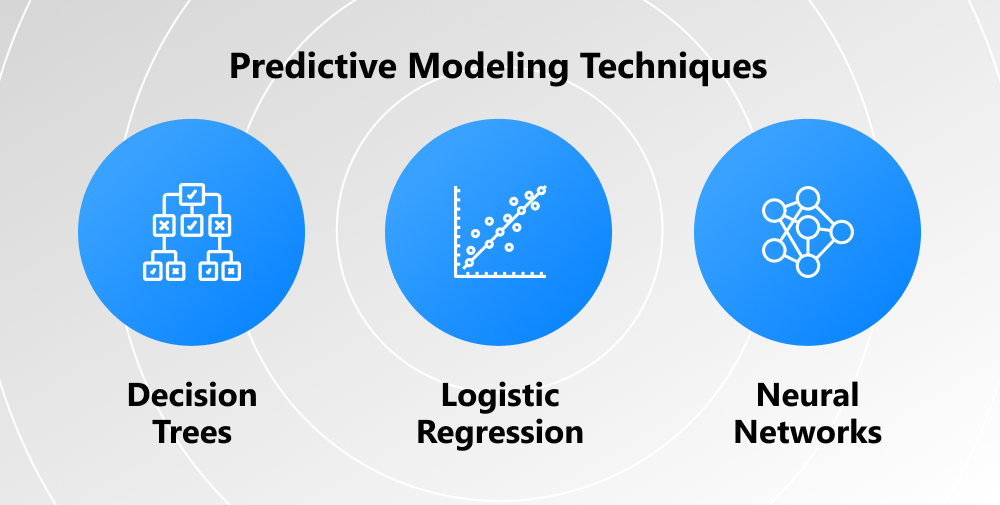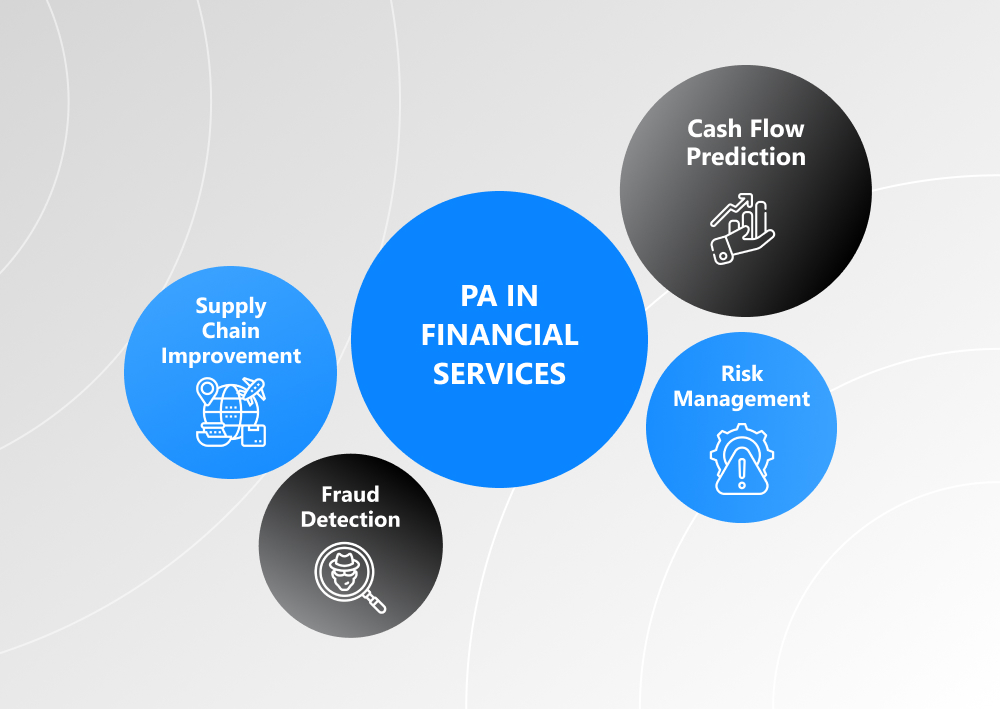Today, we collect more data than ever. Clients are generating data with every interaction they have with your company. With the right technology, such as predictive analytics, we can now leverage that information to foresee what to expect in the future. Surely, every industry can benefit from it, but let's focus on predictive analytics in finance.
Use cases of predictive analytics in financial services are varied. So, how exactly can you apply this technology to enhance financial solutions?
written by:
Alexander Arabey
Director of Business Development
Contents
What Is Predictive Analytics?
Before we plunge into the world of banking and finance, let's clarify what predictive analytics is. Predictive analytics (PA) is a part of advanced analytics that anticipates upcoming trends with the help of four major techniques: data mining, statistics, machine learning, and predictive modeling. PA is a growing area of interest in financial services since it improves customer experience and promotes the organization’s digital transformation.
PA is a growing area of interest in financial services since it improves customer experience and promotes the organization’s digital transformation. Thus, according to Statista, by 2028 predictive analytics software market is expected to reach $41.52 billion. And primarily, it will be used to manage supply chains, to enhance business operations, and to analyze consumer behavior.
Predictive analytics is closely connected with data science. Customers share their opinions on social media, in specific queries, online reviews, and the CRM system. This immense amount of raw data (unstructured data) can be processed either manually or with the help of artificial intelligence. The second variant greatly redistributes a company’s financial resources because a well-developed predictive analytics engine can forecast trends more effectively than the most experienced data scientists.
Top 3 Predictive Modeling Techniques
Once the data is gathered, it should be processed with the help of a special model. So, the predictive analytics modeling techniques analyze big data and patterns and use that information to anticipate future trends, economic, financial, and market risks, and customer behavior. So, let's have a closer look at the most efficient ones!
Decision Trees
Decision tree algorithms analyze data by dividing it into branches to present every possible outcome of numerous decisions. This way helps to trace the customer's chain of reasoning. Decision trees are easy to interpret, that’s why this modeling technique is widely used. When it comes to preliminary variable selection or handling missing values, decision trees also come in handy.
Logistic Regression
The core idea of regression analysis consists in assessing relationships among variables. It's a statistical analysis method that helps to predict a data value by using prior observation of an existing data set. So, the more data is brought in, the more precise image you get.
Neural Networks
This area of predictive modeling is viewed as the most sophisticated one. Created by scientists who were trying to imitate the neurophysiology of the human brain, the neural networks model uses pattern recognition and various AI processes and is very flexible.
Predictive Analytics in Financial Services
Predictive analytics in finance can be applied both to repeated tasks you carry out on a daily basis and to strategic corporate decisions. In fact, PA can enhance a variety of finance processes by revealing weak points of your business. Below you'll find several common examples of using predictive analytics in the financial field in 2022.
Supply Chain Improvement
For customers, the supply chain is the most evident side of a company. That’s why the more effectively your company conducts supply chain analytics, the better it protects its long-term sustainability and business reputation. In this sense, under Supply Chain Management we understand the combination of procurement, logistics, and IT.
But the financial services industry is a whole other world. It’s widely known that banks generate revenue mostly by granting loans. So, it’s a lending process that is viewed as a supply chain in this field. Since nowadays people can get a mortgage loan via the internet without signing real papers, predictive analytics has become significant in this process because it allows the company to assess the client’s creditworthiness and to manage potential risks.
Cash Flow Prediction
An accurate cash flow forecast empowers company leaders by helping them to manage debt repayments, monitor cash turnover, and estimate a company’s liquidity position. But the factors that influence cash movement are numerous. So, predictive analytics can help you study them all to run your business properly.
First of all, the ability to prevent a liquidity crisis is essential for growing companies. The Covid-19 pandemic has brought some uncertainties to the financial industry, so nowadays even profitable enterprises should be examined with predictive analytics in order to create possible cash flow projections.
Fraud Detection
Frauds come in various forms and affect all kinds of industries, and the financial services sector is no exception.
Banks and financial firms are expected to guarantee the highest level of security to their customers. But criminals are always finding new ways to hack the system and to ruin your reputation. So, by applying predictive analytics you can strengthen the security of your insurance company or prevent a fraud attack on the entire banking system.
How exactly does it work? Predictive analytics processes all the fraudulent cases which ever happened in the field and applies received patterns to examining freshly collected data. Such an investigating model can help to secure the verification process, cashless transactions, the use of credit cards and insurance.
Risk Management
Risk management is definitely a crucial part of the overall strategy of financial institutions. It concerns a company’s security, trustworthiness, and vitally important decisions. Definitely, the approaches to handling risks have changed significantly over the recent years, transforming the nature of the finance sector. Nowadays, it's data science and artificial intelligence that are used to provide risk scoring models and increase sustainability.
So, how does it work? With machine learning algorithms that can analyze spending behavior, you get the possibility to check the creditworthiness of potential customers and establish the appropriate credit amount for a particular client. Another way of applying predictive analytics consists in creating a model that forecasts whether a customer will leave or stay. As a result, the company evolves and becomes more agile.
The Future of Predictive Analytics
The financial services industry accumulates a lot of information about its customers. No wonder it abounds in data more than any other industry. Taking this fact into consideration, the demand for predictive analytics and data science in the field of banking and finance will only increase. So, let's highlight the areas of PA development for the near future.
Customer Service
The analytics will keep providing solutions to such significant issues as client service and risky customer segregation. Thanks to the combination of predictive analytics and marketing, it'll become easier to target a particular client and offer him the exact service he needs and can afford. Such an approach will help banks to reduce risks and achieve positive results.
Relationship Development
Customers have higher expectations today than in the past. They have a clear idea not only of what they want but also of your abilities to provide them with the necessary product or service. When you fail to meet these expectations, they can perceive it as intentional. At the same time, by giving clients what they benefit from, financial companies can change the customer experience from neutral to satisfactory. So, predictive analytics will definitely keep evolving in this field.
Retention
As markets develop and expand, the ability to retain customers becomes vital to sustaining a profitable business. Thus, the key challenge for any company is to implement a working customer retention strategy.
Luckily, predictive analytics comes in handy in this matter. Thus, for example, with the help of data science, you can identify the customers who are less likely to return. All that is left to do is to find out the reasons and improve your service to get the customers back. As long as such application of PA successfully works, more industries will turn to it in the future.
Cross-Selling
Cross-selling strategy perfectly works not only in the marketing field but also in the digital banking industry. The ability to offer clients the right service at a fitter moment helps a financial institution stay afloat and meet customer expectations. Thus, when you get a personalized ad in a mobile banking app, it's very likely that you'll click on it or even buy the offered product or service. Such a result is achieved thanks to predictive analytics tools. Since this strategy seems quite effective, advanced bank branches will definitely employ it.
Summing Up
Nowadays banks and financial institutions tend to automate numerous processes as much as possible in order to improve the service and make more profit. This trend is most likely to continue, so predictive analytics will keep evolving to provide efficient solutions for the financial services industry. In case you're interested in enhancing your company's performance, predictive analytics is definitely something to look out for.
If you want to know how to apply predictive analytics to your business, please contact our specialists. Qulix Systems is an expert in software development driven by machine learning, artificial intelligence, and big data.

Contacts
Feel free to get in touch with us! Use this contact form for an ASAP response.
Call us at +44 781 135 1374
E-mail us at request@qulix.com










